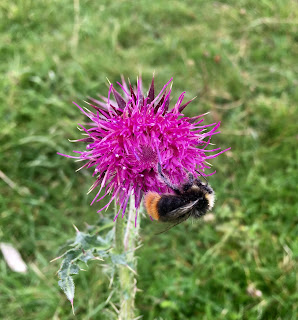Well, I didn't, and I haven't even managed to keep this blog going. But I've swept the floors and brushed away the cobwebs and I'm going to have a another go. Incidentally, it was very nice to see that I've acquired a few new followers while I've been gone - welcome and thanks to you!
So first, a bit of a catch-up about books I've read and enjoyed in the last month or two. Disclaimer: probably because I read too quickly, I don't generally remember books for all that long. Also, I read quite a few of the following on my Kindle, and it's notoriously difficult to go back and check up on things on a Kindle. So apologies for a possible lack of detail and/or accuracy.
I'm an admirer of Kate Atkinson, and particularly of her Jackson Brodie books. Big Sky is the most recent one - and I got this from the library and have it beside me, so that's a plus.
Brodie is an ex-policeman, now a private investigator. He's not actually very good at his job, though somehow or other, he usually manages to sort things out. As Crystal, the sort-of heroine tells her stepson at one stage: "Claims he's a detective... but he's shit at detecting." Crystal is a great character: the trophy wife of a wealthy businessman with an obsession for keeping things neat, tidy and wholesome - why, you will quite correctly be asking yourself? Her past, and her strength of character, are gradually revealed. She may look like a Barbie doll, but she's a tiger when it comes to defending her young. She's one of a whole array of nuanced, flawed characters: Kate Atkinson gets inside the heads of even the bad ones and, without laying it on with a trowel, lays bare their complexities.
The book is very cleverly constructed: different chapters are related from the point of view of different characters, and it's not at all obvious how they relate to each other or where the story is heading. I can't really say any more because it would spoil it. Just one thing: if anyone has read it/does read it, and understands why it's called Big Sky, would you tell me? I think I must have missed that bit.
Susan Hill is another writer acclaimed for both her 'literary' fiction and for her crime novels - if, indeed there is a distinction, which I don't think there necessarily is. I hadn't read her Simon Serailler novels until recently - thank you, to the friend who recommended them!
Serailler is one of those intelligent, attractive, intuitive police officers who crop up from time to time in crime fiction. He reminds me a bit of Dorothy Sayers' Lord Peter Wimsey: like him, Serailler is fatally attractive - fatally, because he is unable to commit himself to anyone, so scatters broken hearts in his wake. He also solves crimes: the small country town where he lives has nearly as many serial killers knocking about as Midsomer. Like Kate Atkinson, Susan Hill is a very good story teller, who likes to get into the heads of all her characters - victims and perpetrators as well as the forces of law and order. She also develops the stories of Simon and his family as the series progresses - particularly his sister, Cat Deerbon, and his very odd father. There did come a point at which I felt there was just too much about the misfortunes of the Serailler family - they really do have a lot of bad luck - and so I've taken a break from the series: in particular there was a storyline involving the father which didn't convince me. But the first few books were very gripping, and I do like the sound of Simon's apartment overlooking the cathedral close. The first in the series is called The Various Haunts of Men.
 |
| This really has nothing to do with the books. It's just a big sky, up above Cheddar Gorge. |













